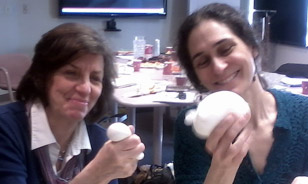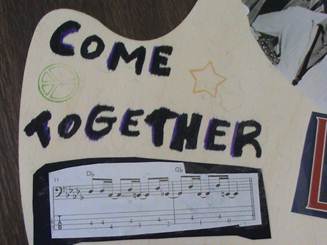 |
 |
|
Program Background
Throughout the project, we were guided by trauma-informed theory, approaches in multi-modal expressive therapies, multiple intelligences theory, mind/body practices of various kinds, and project based learning. Recent research on cross-cultural models for the promotion of mental health, particularly with refugees, supports our program design. Trauma informed practice crosses all disciplines and can enhance our practice in the classroom. Recognizing that trauma is something that stays in the body can help us see our students as physical as well as mental beings, something we tend to forget. Richard Mollica (2006) suggests that, "The healing of the emotional wounds inflicted on mind and spirit by severe violence is also a natural process. Mind and body are powerfully linked, from the molecular level up to the thoughts and social behaviors of a person. Mind and body are similarly interrelated in their potent curative influence. After violence occurs, a self-healing process is immediately activated, transforming, through physical and mental responses, the damage that has occurred to the psychological and social self." According to Murray et al (2010), "Considerable emphasis has been given more recently to the need for interventions that rely less on medical models of psychological distress that unduly emphasize stress-related trauma and more on psychosocial models that promote positive personal change. Such interventions aim to develop a sense of stability, safety, and trust, as well as to [assist clients to] regain a sense of control over their lives. This may best be achieved by engaging individual clients, families, and whole communities in programs that place emphasis on individual and social growth and change in response to adversity." (p. 582)
We started our project with a two-day institute. Mental health workers presented background information about chronic stress and trauma, particularly focusing on cross-cultural implications and the effects on cognition and learning. Other speakers engaged participants in mind/body activities and expressive arts projects, modeling possible approaches for students. Participants developed a next steps action plan and began to implement it at their own sites. Three additional all-day workshops were held during the project to build our knowledge base and to explore creative strategies for the classroom. Monthly meetings allowed for updates and troubleshooting. Wiggio provided a (free) virtual project space where we could share relevant research, classroom materials, and project updates. The director provided onsite support, sometimes co-teaching, participating in expressive arts activities, documenting events through videotaping or photo shoots, and sometimes substituting in classes so teachers would be free to observe each other teach. Participants were given stipends for their time and materials and were encouraged to use the funds flexibly. Some programs hired community artists to work with them and their students; some hired yoga trained educators; and others enrolled in specialized training themselves (Brain Gym training, for example). This flexible, interactive aspect of the project was essential to its success. At the end of the two years, we convened to celebrate and share our experiences and to view some of the final products that emerged over the two years. We also engaged in our own affirmation box activity. Participants at initial institute wrap up their two days with a drum circle:
Students included White, American-born, dislocated factory workers; White and African American homeless women; refugees from Iraq, Bosnia, Somalia, Rwanda, Bhutan, and Haiti; and immigrants from Cape Verde, Dominican Republic, Central America, China, and Mexico. Throughout this website you can find practical tools (lesson plans, resource links, and listings), research citations, and images of student work. We have also included the stories participants wrote about their experiences with promoting mental health in their classrooms through stress reduction strategies and expressive arts. We wanted to share the messy parts as well as the tidy outcomes, so please don’t overlook the stories in your reach for tools. Thanks for joining us on this site! |
| New England Literacy Resource Center |
Copyright 2008 World Education, Inc.
Comments/Questions? Email us at wei@worlded.org
 ts, but they are not always comfortable knowing how to respond to the emotional needs of students. While teachers are not therapists, they can be educated in approaches that promote emotional and psychological well-being, and incorporate strategies into the classroom that help students to learn more efficiently.
ts, but they are not always comfortable knowing how to respond to the emotional needs of students. While teachers are not therapists, they can be educated in approaches that promote emotional and psychological well-being, and incorporate strategies into the classroom that help students to learn more efficiently. Our intention was to learn more about how chronic stress, trauma, and adverse life experiences affect learning. We wanted to explore our role as educators in addressing these issues so we could make conscious choices for creating safe, stable, and joyful sites and so we could choose appropriate strategies to help students - and ourselves- manage the toxic stress that interferes with learning.
Our intention was to learn more about how chronic stress, trauma, and adverse life experiences affect learning. We wanted to explore our role as educators in addressing these issues so we could make conscious choices for creating safe, stable, and joyful sites and so we could choose appropriate strategies to help students - and ourselves- manage the toxic stress that interferes with learning.